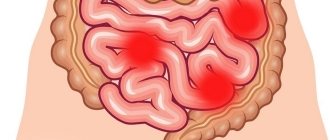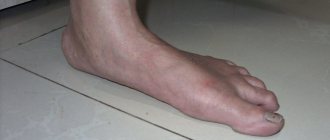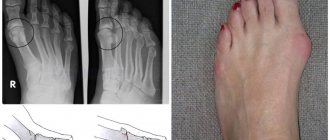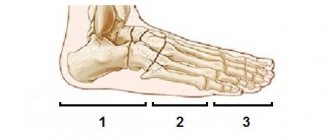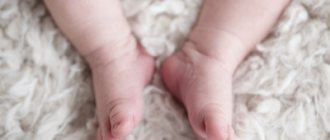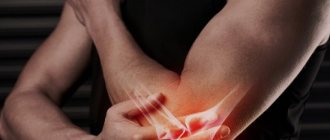From this article you will learn:
- What is transverse flatfoot?
- Types of flat feet
- What are the causes of transverse flatfoot?
- Symptoms of transverse flatfoot
- What to avoid with transverse flatfoot
- Diagnosis of transverse flatfoot
- Treatment methods for transverse flatfoot
- Massage for transverse flat feet
- Treatment of transverse flatfoot at home
- Effective exercises for transverse flat feet
- Prevention of transverse flatfoot
- Orthopedic shoes for transverse flat feet
Transverse flatfoot is diagnosed if, due to certain changes in the arch of the foot of the same name, its functions are reduced - compensating for shock loads during movement and maintaining a state of balance in an upright position.
In fact, the transverse and longitudinal arches of the foot protect our spine and joints from increased stress that can occur when walking, running, etc. That is why it is so important to diagnose the onset of flat feet in time in order to avoid serious threats to health in general.
What is transverse flatfoot?
Transverse flatfoot is a drooping transverse arch, which causes the foot to flatten and come into full contact with the floor. The metatarsals in this case fan out and the big toe deviates outward, causing the foot to become shorter in length. In a healthy person, the foot has arches (curves), which perform a shock-absorbing function and soften any load. Only the correct anatomical structure of the lower extremities allows you to avoid problems in the field of orthopedics.
Most often, people who have been on their feet for a long time know firsthand what it is – transverse flatfoot (grade 1, 2 or 3). At the same time, for those who are constantly in motion, a load is placed on the lower limbs that the ligaments are not able to withstand. In people who are forced to stand on their feet for a long time, on the contrary, the ligamentous apparatus becomes weak. It is worth noting that this happens in most cases (more than 80%). A less common cause of flat feet is a fracture of the foot. Sometimes the development of such a pathology can be affected by rickets, in which weakening of bone tissue is observed.
According to statistics, representatives of the fair sex suffer more often from transverse flat feet than men. As a rule, this is about 50% of patients who turn to a doctor for help. This disease begins to manifest itself at the age of 37–40 years. Thanks to obvious symptoms and effective treatment, transverse flatfoot can be managed at an early stage of development.
What causes?
Foot deformities in children can be congenital or acquired.
At the stage of intrauterine development they are provoked by:
- abnormal location of the fetus in the uterus;
- prematurity;
- congenital pathologies of the musculoskeletal or nervous system (cerebral palsy, impaired innervation of muscles, connective tissue dysplasia);
- oligohydramnios, multiple pregnancies, small space for the fetus leads to mechanical pressure on the lower limbs, causing deviations in their development;
- intoxication, smoking, taking alcohol or drugs by a woman during pregnancy;
- intrauterine infections;
- hereditary factor.
Common causes of acquired foot deformities are lack of physical activity and improperly selected shoes.
With a lack of physical activity, the foot muscles weaken over time and are less able to hold the bones in the anatomically correct position.
Contributes to this:
- moving mainly on hard, flat surfaces: smooth floors in an apartment, tiles or asphalt outdoors;
- lack of exercise;
- refusal of preventive massage, exercises to maintain foot muscle tone.
Bad shoes have a detrimental effect on the formation of a child’s foot in the first years of life. Therefore, there are a number of requirements for its selection. It should ensure proper formation of the foot and distribution of the load, supporting the arches. For this purpose, shoes for small children are equipped with instep supports, a small heel, a flexible sole, and heel fixation.
Acquired foot alignment disorders also cause:
- increased load on the joints of the legs due to excess weight, early walking (in children they are very mobile and are easily displaced);
- diseases of the musculoskeletal system;
- birth injuries;
- fractures, bruises, sprains, deep cuts, burns in the foot area;
- long-term immobilization of the limb after injury (wearing a cast, orthosis);
- vitamin deficiency;
- past polio;
- suffered acute respiratory viral infections with complications in early childhood;
- metabolic disease;
- endocrine diseases (hypothyroidism, diabetes mellitus);
- advanced rickets, leading to disturbances in bone mineralization, muscle development, and ligaments;
- inflammatory processes in muscles, ligaments, joints.
Types of flat feet
There are three types of disease according to the location of the vaults:
- Transverse flatfoot – characterized by a shortened, lowered transverse arch and an enlarged anterior part.
- Longitudinal flatfoot - here the length is increased and the longitudinal bend is decreased. Most often, this type of pathology affects people aged 15–26 years.
- Longitudinal-transverse flatfoot (combined). This type is the most difficult because it causes serious consequences for the musculoskeletal system due to rapid wear and tear. In this case, the disease leads to postural deformation and problems associated with the spine:
- radiculitis;
- osteochondrosis;
- intervertebral hernia.
Degenerative changes and inflammation also occur in the joints (osteoarthritis, arthrosis, coxarthrosis).
The consequences of flat feet are inextricably linked with:
- lameness, the cause of which lies in the poor functioning of the venous vessels in the calf muscles;
- impaired coordination of movements;
- varicose veins;
- formation of heel spurs;
- impaired functioning of the cardiovascular system.
If a patient has flat feet, accompanied by varicose veins, diabetes, or a tendency to heart problems, then there is a high probability of trophic ulcers appearing on the legs, feet and pelvis. In addition, pathological swelling of the tissues often occurs.
How to warn?
To prevent foot deformities in children, doctors advise parents to follow simple recommendations:
- You shouldn’t put any weight on your baby’s legs before 7–8 months, don’t try to force him to stand on his legs, teach him to walk early. When the child is ready, he will do it himself;
- consult a pediatrician about preventing rickets, walk more in the fresh air on sunny days to ensure a sufficient supply of vitamin D;
- choose the right shoes for your child with a high, rigid heel that helps keep the heel on the axis of the shin, a bendable sole, and an instep support;
- make sure that the child is active, moves a lot, and does not gain excess weight;
- provide adequate nutrition, rich in vitamins and minerals necessary for the proper development of the musculoskeletal system;
- do leg exercises with your child;
- undergo regular examinations by an orthopedist (at 1, 3, 6 months, at 1 year, at 3 years, from 4 years - once a year), especially if there is a hereditary predisposition to orthopedic diseases.
0 0
What are the causes of transverse flatfoot?
The most common reasons that can provoke the development of transverse flatfoot (photo above) are the following:
- Bad heredity.
In this case, the disease is congenital and is called “aristocratic foot”. It is caused by weak muscles of the arched vault. A person with this pathology can live a full life if he wears comfortable shoes and adheres to a healthy lifestyle.
Recommended articles on the topic:
- How to massage the abdomen for weight loss: different techniques for health and beauty
- Stone massage: description, benefits, methods
- MRI of three parts of the spine: when is it necessary and what are the features of the procedure
- Anomalies associated with the ligaments and muscles of the foot.
If a person has impaired development of ligaments or muscles, leading to incorrect placement of the phalanges of the fingers, this can cause them to spread and ultimately provoke transverse flatfoot.
- Excess weight.
The flattening of the foot in this case occurs due to excessive stress on its ligaments and muscles.
- Professional activities that involve increased pressure on the foot.
If a person has to stand for a long time during the working day, the foot becomes unbalanced, which ultimately leads to acquired flat feet. Most often, this is observed among teachers, lecturers, hairdressers, etc.
- Injuries.
In most cases, it is injuries that cause flat feet in men, since they (unlike the female part of the population) more often experience bone fractures, sprains and muscles, dislocations, and other similar troubles.
- Wearing uncomfortable shoes.
Flat feet are often caused by poor foot hygiene, high heels, and improper shoe lasts. When a representative of the fair sex wears high-heeled shoes, she redistributes the weight of her own body so that it falls on the forefoot, which over time leads to bone deformation.
Right choice
The inventor of shoes with arch support was Salvatore Ferragamo (1898–1960), an Italian who became the favorite shoemaker of Hollywood stars. He made shoes for Gloria Swanson and Marlene Dietrich. It was Ferragamo who first created “flat” shoes for Greta Garbo, “stiletto” heels for Marilyn Monroe, and platform shoes for Carmen Miranda, whose height was only 155 cm.
One of the most common causes of flat feet is “wrong” shoes. As soon as your child starts to stand up, it's time to buy him his first shoes.
– high and rigid heel for fixing the ankle joint and longitudinal arch in the correct position
– lacing or Velcro that gently secures the leg
– natural materials used in the production of shoes
– insole with arch support
– perforated “breathable” surface
– stable, hard and non-slip sole with a small heel (0.5 cm)
– wide, round toe that prevents pinching of the toes
Symptoms of transverse flatfoot
If pain begins to appear in the lower extremities, this indicates that something is wrong in the body:
- Pain increases throughout the day. By evening it appears in the ankle joints, knees and muscles. Most often, this picture is observed in those who spent most of the day on their feet (moving or standing). At first, the pain goes away after rest.
- Discomfort appears in the heel and arch of the foot. In addition, unpleasant sensations are also present in the calf muscles. Over time, pain occurs in the knees, thigh muscles, lower back, and hip joints.
Symptoms that appear with flat feet at the very beginning of the development of pathology:
- First, the legs quickly get tired, then fatigue spreads to the entire body. As a result, chronic fatigue syndrome occurs.
- It is difficult to maintain balance while squatting.
- Overexertion and cramps in the calf muscles.
- Feeling of heaviness in the legs.
- The feet begin to swell.
- Thickening of the skin occurs around the beginning of the big toe, which causes discomfort when moving and the formation of a hard callus.
- Pain in the calf and thigh muscles, which in the evening moves to the lower back. After a night's sleep it disappears.
- It is difficult to choose shoes that are comfortable for your feet.
- Uneven wear of the soles and heels (their inner part is worn out first).
- The size of the foot increases, especially in terms of width. As a result, you have to buy shoes a size larger, because the usual ones are no longer comfortable.
- Severe discomfort when wearing high-heeled shoes.
- Posture is impaired, and due to the fact that the shock absorption of the feet deteriorates, the gait becomes awkward.
- A “bone” grows on the big toe.
To determine the method of treatment, as well as preventive measures, it is necessary to diagnose the disease, taking into account the existing symptoms. However, there is a way to determine transverse flatfoot yourself:
- Lubricate your feet with cream or moisten with plain water.
- Place a white sheet of paper on the floor and stand on it, leaving a foot print (it should be clear).
- Take a graphite pencil and trace the resulting drawing. After this, a straight line is drawn from the inside of the heel to the part of the foot where the toes begin.
- Now you should lower a perpendicular line to the outside of the foot in the place where its widest part, formed by the arch, is located.
- If in a given place the imprinted part of the foot occupies at least half of the perpendicular line, then we can assume the presence of flat feet.
As for transverse flatfoot in children, as they grow, the norms will be somewhat different from those used to diagnose the disease in adults, since the foot is still developing. If in the second case we can say for sure that this pathology is present, then similar indicators in the child may be quite normal for a developing leg at his age.
We recommend
Anti-wrinkle facial massage: 10 effective techniques Read more
How to independently determine the presence of flat feet
In addition to identifying symptoms characteristic of the disease, you can additionally conduct a simple test at home for the purpose of tentative diagnosis. Lubricate the sole of the foot with any coloring substance, for example, fatty cream. Place a sheet of white paper on the floor and leave your foot print on it. The main thing is that the load on the foot is uniform, that is, you need to stand in your normal position, without deviating to the side.
Using a pencil, draw a parallel line from the heel to the big toe and another line perpendicularly - from the deepest neckline to the outer edge of the foot. Next you need to evaluate the print. If it occupies half or more of a perpendicular line in the area of the narrowest part of the foot, this may indicate the presence of flat feet. The norm in children and adults is different, so this test in children can indicate the normal development of the structure of the foot.
What to avoid with transverse flatfoot
To prevent complications when diagnosing transverse flatfoot, you should avoid:
- standing on your feet for a long time;
- intense sports;
- strong physical activity;
- wearing flat-soled shoes (heels 3–4 cm high are required);
- using other people's shoes, since each person has an individual foot shape;
- wearing models that are the wrong size (small, large, narrow or wide);
- shoes with a platform, wedge and very thin soles;
- constantly wearing sports models;
- shoes that do not have backs, but only thin straps (the foot must be secured).
Most often, transverse flat feet affect the fair sex, not men (8:2), and this is not at all surprising, since women wear narrow stilettos for several hours in a row every day. Thus, in pursuit of beauty, ladies forget about their own health.
Useful tips
Simple preventive measures will help prevent the development of flat feet:
– the right choice of shoes, which should be made taking into account the growing child’s foot. Don’t press or rub anywhere, but don’t be too loose;
– each child has his own shoes: due to shoes worn out by a brother or sister, the load on the feet may be incorrectly distributed;
– the presence in the diet of foods rich in phosphorus and calcium, which prevent the development of rickets;
– in summer – sunbathing, in winter – preventive intake of vitamin D as prescribed by the pediatrician;
– moderate physical activity. Avoid activities with axial load - gymnastics, dancing and weight lifting;
– walking barefoot on pebbles, sand, earth, grass, which causes the feet to constantly strain. But you only need to walk on a flat and smooth floor in orthopedic shoes.
Diagnosis of transverse flatfoot
Flat feet can be either congenital or acquired. In addition, it varies in degrees:
- Mild transverse flatfoot (1st degree). In this case, the deviation of the thumb is no more than 19°. The patient feels weakness in the legs, there is slight swelling.
- 2nd degree of transverse flatfoot (moderate). The deviation of the thumb here can be up to 30°. The pain becomes stronger, the person finds it difficult to move.
- Severe transverse flatfoot (grade 3). The deviation of the thumb is more than 35°. Deformation of the foot, pain in the legs and lower back are observed. The person moves with great difficulty.
Regardless of age, the symptoms of the disease are the same, but only a specialist can confirm it. What methods will be used for treatment depends on what caused the pathology. Only a doctor can determine them, so you don’t need to diagnose yourself and carry out therapy yourself, otherwise you can only make things worse and cause complications.
- Diagnosis of transverse flatfoot using radiography of the feet.
During this procedure, the patient is in an upright position. In order to obtain more detailed information, photographs are taken from different angles. An x-ray is prescribed for transverse flatfoot only after examining the limbs, checking muscle reactions, taking into account the wear and tear of shoes and gait.
The specialist also conducts computer diagnostics, through which you can obtain information regarding the type of arch of the patient’s foot, as well as the load on it. This procedure allows you to find out which points are subject to excessive pressure from a person’s weight.
We recommend
Therapeutic massage for the back: features, indications and contraindications Read more
- Studying the foot using a stopometer, ruler, protractor, compass.
The method consists of calculating the podometric index based on data obtained by measuring the foot using instruments and studying the print on paper. Normally, the indicator should be in the range of 29–31. If the ratio of foot width to length increases and is more than 42, the patient is diagnosed with transverse flatfoot.
It is worth noting that with this disease, pathological changes can affect nerve fibers and blood vessels, so the doctor prescribes a consultation with a neurologist and phlebologist surgeon.
Changing the mode: what will have to be changed
After this diagnosis, many things need to be reconsidered. For example, you should not buy a girl high-heeled shoes, or allow her to constantly wear sneakers with thin soles. You also need to update your shoes more often, because they take on the wrong shape of the affected leg. This will prevent progressive spread, because after 20 years it is almost impossible to correct. Therefore, if you are still thinking about how to treat flat feet and whether it is worth doing this in children at 3, 4, 7, even 11 years old, be sure to start therapy. The sooner you start, the better it will be.
Treatment methods for transverse flatfoot
Recently, people aged 23–56 years have been turning to doctors with complaints of leg fatigue, swelling, pain and bone growth on the foot. However, treatment of longitudinal and transverse flatfoot is prescribed to each patient individually depending on the symptoms, degree and severity of the disease.
- Therapeutic correction.
It is used at the initial stage of development of pathology and involves the use of medical devices, for example, for an inflamed metatarsophalangeal joint, correction is performed with rollers. They are placed between the second and thumb and are fixed to the side, thereby restoring the anatomical position.
If you have transverse flatfoot, you can also choose a device such as orthopedic insoles, which allow you to restore the physiological curve of the foot, reduce the load on the spinal column and ankle joint and stop the progression of the disease.
Often, orthopedic shoes are prescribed to support the foot, usually after surgery for severe cases of the disease.
- Drug therapy.
In this case, the patient is prescribed non-steroidal anti-inflammatory drugs (NSAIDs) based on Kerotolak, Indomethacin and Diclofenac, which are aimed at eliminating pain in muscles and joints. In case of severe discomfort and inflammation, intravenous or intramuscular administration of drugs is prescribed.
- Exercise therapy and physiotherapy.
These methods are used as an adjunct to the main treatment of transverse flatfoot in adults. Most often they are prescribed at the first and second stages of the disease, as well as after surgery during rehabilitation.
Physiotherapy is used in the presence of inflammation and includes the following activities:
- electrophoresis;
- mud baths;
- shock wave therapy (UHF).
Thanks to physiotherapy, joint mobility is restored, metabolic processes and microcirculation in muscle tissue are improved.
Shock wave therapy is used to destroy microscopic crystals of calcium salts deposited in tendons, joints and ligaments, as well as to launch regenerative processes in cells and the rejuvenation mechanism. This procedure is very effective in relation to cartilage and bones, since it has a positive effect on them without causing harm to the muscles. In addition, it improves blood flow, that is, it increases it, restores ligaments that help cope with stress on the foot.
Electrophoresis using calcium ensures the delivery of the element to the bones. This procedure is carried out because in tablets or injections it is not always well absorbed by the body.
Heat therapy is also prescribed using paraffin-ozokerite applications, which warm up the disturbing area, eliminate pain, improve metabolism and increase immunity.
- Surgical treatment.
The most effective way to restore the anatomical structure of the foot with transverse flatfoot is surgery. It is carried out in order to redistribute the tendons and muscle tractions responsible for the position of the toes. In some cases, this requires removing a fragment of bone tissue (with valgus transverse flatfoot).
Making insoles
Making insoles
- custom size;
- reconstruction of the arch of the foot;
- energy-saving depreciation;
- optimal thermoregulation.
Methods for planning the production of insoles are mechanical and computer. Although mechanical methods were historically the first, today the computer method is increasingly used in modern clinics.
The mechanical method involves obtaining a cast of the foot. In the future, orthoses are made on its basis. However, the technique has one huge drawback: it does not take into account the load on the foot when walking. The impression is taken in a static body position. However, when walking, areas of overload shift, and in different ways for different people. The cut is adjusted subjectively, based on the patient’s feelings, not on objective measurements.
The computer method is more accurate. Pedobarography is performed using a special apparatus. Many parameters are assessed: the position of the direction of the patient’s center of body mass, his movement when walking. There are 5 zones of greatest load on the plantar surface:
- finger;
- metatarsal (metatarsophalangeal joints, rollover axis);
- medial middle region;
- lateral medial region;
- the heel area, which is the axial support.
Based on the results, the structure of the integral load graphs is assessed. A model of the insole for manufacturing is formed. After its production, the orthosis is adjusted to the patient, based not on his sensations, but on the data of pedobarography and photoplantometry.
The use of individual insoles allows obtaining positive treatment results after 1.5 years in 85% of patients. Their pain and muscle fatigue when walking decrease or disappear. Measurements show an increase in arch height. Further treatment can be carried out using other insoles. The examination and orthoses are made again, as the configuration of the foot changes. In a few years, in this way, a person can completely recover from flat feet, after which the need for further use of insoles will disappear.
Massage for transverse flat feet
With the help of massage, you can get rid of symptoms of transverse flat feet such as pain, swelling of the feet and inflammation. In addition, it helps speed up lymph flow, improve blood flow, and tone muscles. The positive effect of massage can only be obtained if it is done regularly, that is, 12–15 minutes, 15 sessions per month.
Before starting the procedure, it is best to steam your feet in a bath with the addition of herbal infusion or sea salt.
Massage for transverse flat feet is done as follows:
- Warm up the skin on the legs and feet by stroking and rubbing.
- Using kneading, squeezing and tapping techniques, massage the calf muscles.
- Massage the soles of your feet thoroughly.
- Work the thumbs of the lower extremities.
This massage has a positive effect on biologically active points and allows you to get rid of transverse flat feet.
We recommend
Laser aesthetic cosmetology: perfect technology for an ideal appearance Read more
Causes of occurrence in children and factors that cause pathology
There are many situations that in one way or another affect the health of children's feet. The main factors that can provoke the development of the disease, but do not yet guarantee its occurrence:
- heredity - if mom or dad had such problems, then the child will have to immediately purchase preventative shoes and engage in therapeutic exercises;
- foot injuries;
- excessive load (due to large body weight or initial obesity, during weightlifting, with constant weight lifting);
- rickets;
- muscle weakness due to insufficient physical development, lack of physical education;
- paralysis (for example, cerebral palsy).
Studies have been conducted that urban children who constantly wear shoes (rather than barefoot) develop this disease more often than their rural peers. In addition, due to the lack of physical activity, instead of which smartphones and computers are used, posture is disturbed, which also affects the appearance of problems of the lower extremities.
Treatment of transverse flatfoot at home
To treat transverse flatfoot at home, as well as eliminate its symptoms, folk remedies in the form of decoctions and tinctures are also used.
With their help, you can get rid of pain and restore muscle ligaments after overexertion. Traditional methods give maximum effect if they are used in complex treatment.
- If a patient suffers from aching joints, wormwood will come to the rescue. It must be washed, placed on the feet and wrapped with a warm cloth.
- A mixture prepared from iodine and citric acid (in a 1:1 ratio) will help cope with the symptoms of transverse flatfoot:
- mix the resulting solution well and add aspirin (two tablets);
- apply to the problem joint and wrap it with warm material;
- Only 3% iodine should be used, no more, otherwise you may get a skin burn.
This procedure must be carried out for three days, after which you should take a break for a week.
To relieve pain and relax the muscles on the feet, it is recommended to regularly use baths with the addition of sea salt or herbal lotions:
- Pour 1 liter of warm water into a basin, add sea salt (1 tbsp), mix well and immerse your feet in it. The duration of the procedure is 10–20 minutes.
- Instead of salt, you can add an infusion made from linden, chamomile, mint, oak bark or sage to the water.
- After completing the procedure, the feet should be thoroughly dried and massaged, applying the cream intended for this purpose.
To increase muscle tone, as well as hardening, baths or contrast showers are required. You can take two containers, pour hot water into one and cold water into the other. Next, the feet are placed in them one by one, which allows you to increase the tone of the muscles and the whole body, as well as improve blood flow.
As for the contrast shower, the mixer lever switches from cold to hot water and back about 3-7 times.
This procedure has a contraindication that applies to the fair sex. They should avoid contrast showers during menstruation.
If transverse flatfoot is in an advanced state, and no massages, lotions or rest help cope with the pain, you should turn to drug treatment:
- Analgesics (aspirin, paracetamol, Flugalin, Indomethacin and Ibuprofen) will help relieve acute manifestations of the disease.
- Ointments (indomethacin, Dolgit, Voltaren gel) can also help get rid of pain.
Classification of the disease
The foot has two arches. Therefore, it is quite reasonable to distinguish between the forms of the disease - longitudinal and transverse flatfoot. The symptoms and treatment of each are discussed below. There is also a mixed (combined) version of the disease.
Classification of the disease by type also provides for the separation of acquired and congenital flat feet. The first case is extremely rare and is the result of abnormal fetal development. Acquired flat feet can appear at any age. It, in turn, is divided into several subspecies:
- static (occurs due to decreased muscle tone);
- rachitic (as a result of vitamin D deficiency in the body, the muscle system is weakened);
- paralytic (develops against the background of polio);
- traumatic (appears as a result of injuries and bone fractures).
Effective exercises for transverse flat feet
Exercises specially designed for people suffering from this disease are more effective in combating transverse flatfoot in adults. They allow you to strengthen muscles and stop the development of the disease.
Exercise therapy helps improve tissue tone and improve blood flow in the lower leg. The complex must be selected in such a way that the effect occurs on several muscle groups of the foot at once. These are exercises from various positions (standing, sitting, lying down) using small objects, a gymnastic stick and inclined planes.
For each patient, the course of classes is selected individually depending on the type of pathology and its severity. Therefore, it is necessary to begin implementation only after consultation with a specialist, namely an orthopedist, who will offer exercise therapy specifically for you, so that it is effective for the development of the muscles and ligaments of the ankle.
To get the maximum results from the exercises, they should be done in the morning, since at this time the muscles are not yet tired. Moreover, it is necessary to start with small loads and gradually increase them. It is advisable to repeat the complex two to four times a day.
- Starting position – lying on your back.
Lie on the floor face up, legs slightly apart. Next, the toes must be squeezed and unclenched for two minutes.
The position is the same as in the previous exercise. The movements in this case are made not with the fingers, but with the feet. They should be rotated first clockwise, then counterclockwise.
You need to pull the toes of your feet towards your head. This can be done with each leg separately or with both legs at once.
The lower limbs in this exercise should be spread and bent so that the soles of the feet touch each other. Next, leaning on your feet, you need to try to make clapping movements with your heels, but at the same time your toes should not separate.
- Exercises while sitting on a chair.
Make a fist with your right hand and place it between your knees. At this time, the foot is placed on the edge, that is, the inner part is raised from the floor, and the outer part, on the contrary, is pressed.
Place your hands on your knees, after which you need to lift the heels of your feet, while leaning on your toes. This exercise must be performed first with both legs, then alternately.
Now you should do the opposite, that is, it is not the heels that are raised, but the toes of the feet. The starting position is the same.
Place small items on the floor. You need to collect them all using only your toes, that is, hold the thing with them and, holding it, pass it into your hand.
The next exercise is to make movements with your feet that resemble a caterpillar crawling forward. It is necessary to bend your fingers and, leaning on the floor, move forward.
- Exercises in a standing position.
Standing on the floor, you first need to rise on your toes as many times as you can, and then do the same, but lifting the heels of your right and left legs alternately.
The exercise involves lifting your toes off the floor and standing on your heels. You should do this as much as you can.
In the same starting position, that is, standing exactly on the floor, you need to rise on your toes and, while maintaining balance, perform half squats.
Why does it appear
In 90% of this, incorrectly selected shoes are to blame, for example, due to the lack of shock absorption and instep supports. Parents also often select models for growth, which also deforms the foot. The obesity and high weight of the child create more pressure on the legs, the growing body cannot withstand this, and this disease occurs.
Therefore, it is important to choose good orthopedic and preventative summer, winter and demi-season shoes from us - Ortopanda has a large selection of comfortable models made from corrective materials.
Prevention of transverse flatfoot
You should not wait until the disease has gone too far. It is always easier to prevent deviation than to try to cope with it and its consequences later. The best prevention in this case is walking, and it is advisable to do it barefoot on pebbles, sand, exercise equipment, a massage mat or any other uneven surface.
Therapeutic gymnastics for transverse flatfoot includes actions such as walking on your heels and toes and rolling from one side to the other. To make it less boring, you can replace all this with dancing. They will not only prevent the appearance of transverse flat feet, but will also bring a lot of positive emotions.
It is important to eat right, that is, eat healthy foods, vegetables and fruits. It must be remembered that excess weight puts excess stress on the arches of the feet.
For preventive purposes, you can buy orthopedic insoles for transverse flat feet, which can distribute pressure on the muscles of the foot and relieve tension from areas that are in constant tone. In addition, thanks to such devices, the correct position of the legs is formed during movement, and problems associated with the musculoskeletal system are prevented. It is worth noting that you can buy ready-made insoles for transverse flat feet or order them in an orthopedic salon according to individual sizes.
The main component of the prevention and treatment of the disease at the initial stage is wearing special shoes, which are made taking into account the deformation of the foot. It allows you to get rid of growths and calluses, as well as reduce fatigue of the lower extremities and improve blood circulation.
When choosing orthopedic shoes, you need to consider the following:
- a backdrop with a leather insert for greater density is required, which will secure the foot;
- the presence of a wide, stable heel and platform;
- the fullness should be appropriate, that is, it is a wide but at the same time tight-fitting sock;
- there should be no seams inside that would cause inconvenience when moving.
For the manufacture of orthopedic shoes, only natural, environmentally friendly materials are used. In addition, the sole should not be as hard as the product itself.
Orthopedic shoes for transverse flat feet
Before orthopedic shoes go on sale, they must undergo clinical tests and also receive a certificate for compliance with the declared level and quality.
Products manufactured for the correction of flat feet are equipped with:
- an insole in the place where the longitudinal arch of the foot is located;
- an instep support that ensures a smooth roll through the foot and also absorbs vibration while walking;
- a sole that bends well;
- Thomas heel, designed in such a way that its inner part is slightly elongated, which ensures balancing and support of the foot while walking, and also prevents falling inward.
Determining the completeness of the block, as well as the rise, is carried out with the expectation that various orthopedic devices will be installed in it. Preference should be given to models with Velcro or laces, since they are much easier to adjust to the shape of the leg.
At the moment, the market for such products offers a fairly wide range of orthopedic shoes, ranging from slippers to boots. In addition, in appearance it is no different from the usual one, and it also looks aesthetically pleasing. It is worth noting that you can walk in such shoes throughout the day, if necessary.
Orthopedic insoles for transverse flat feet are very often used both for treatment and for preventive purposes.
As for which insoles for transverse flat feet are right for you, it is worth noting that these products are made taking into account the individual characteristics of each patient. Three methods are used to make insoles:
| Mode of production | Manufacturing process |
| Insoles are modeled on a computer | A special digital scanner is used for work. The patient stands on it, after which the device measures the force acting on different parts of the foot, records it and sends the received data to the computer. Next, the program models the insoles after processing the results obtained |
| Using a plaster cast to create a model of the foot | During thermoforming, insoles are made from plaster cast using a special material. |
| Making a foot model using biofoam | Insoles are made in this case according to a model made of biofoam |
Orthopedic insoles for longitudinal and transverse flat feet can be made from both natural and synthetic materials, for example, polyethylene foam, tanned animal skin, microporous rubber and elastic plastic. For people who are overweight, more durable options such as graphite and steel can be used.
Orthopedic insoles help stop deformation of the ligaments and bones of the foot. They can also be worn for preventive purposes, to relieve pain in the lower back and leg joints. Experts advise using them constantly, both at home and outside.
For prevention, wearing orthopedic shoes is necessary because it prevents foot deformation due to transverse flatfoot, the formation of heel spurs and hard calluses on the toes.
In addition, it allows you to reduce the load on the spinal column, hip and knee joints. For the manufacture of such shoes, materials of natural origin are used. The presence of an upper stabilizer and a rigid heel provides reliable fixation of the heel and midfoot, and thanks to the arch support, the arches are supported.
In order to cope with transverse flatfoot and associated cosmetic problems as quickly as possible, it is necessary to promptly identify the disease, select the correct treatment method, and also fulfill all the specified rehabilitation conditions.
Nowadays, you no longer have to spend a lot of time performing complex and unpleasant procedures at home. It is much easier to seek help from real professionals - the Veronika Herba beauty and health center, equipped with effective and modern equipment.
Why clients choose Veronika Herba beauty and health center:
- This is a beauty center where you can undergo treatment for transverse flat feet at a reasonable cost, and you will be treated by one of the best specialists in Moscow. This is a completely different, higher level of service!
- You can receive qualified help at any time convenient for you. The beauty center is open from 9:00 to 21:00, seven days a week. The main thing is to agree with your doctor in advance on the date and time of your appointment.
Sign up for a consultation with a specialist by phone +7 (495) 085-15-13, and you will see for yourself!
Drug therapy
Medicines are used to relieve unpleasant symptoms. They cannot cure the disease.
A doctor should prescribe medications, as they may have contraindications. In addition, prescription medications may be prescribed if necessary. The doctor may prescribe:
- non-steroidal anti-inflammatory drugs (Diclofenac, Ibuprofen) – relieve pain;
- muscle relaxants (“Mydocalm”, “Sirdalud”, “Tolisor”) – relieve muscle spasms and eliminate cramps.

